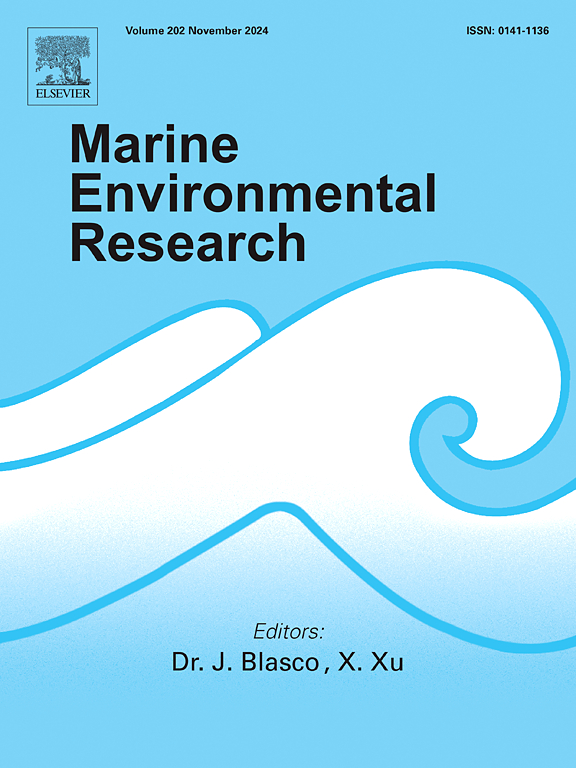桡足动物对东海原心藻和海岸骨骸藻的行为反应
IF 3.2
3区 环境科学与生态学
Q2 ENVIRONMENTAL SCIENCES
引用次数: 0
摘要
近几十年来,有害藻华(HABs)严重威胁着河口和沿海生态系统。有害藻华对浮游动物的不利影响已被广泛研究,但浮游动物应对有害藻华的策略尚不清楚。桡足类Calanus sinicus是北太平洋春季和初夏最具优势的浮游动物物种,与此同时,硅藻costatum和鞭毛藻proorocentrum donghaiense也频繁繁殖。为了研究sinicus在HAB条件下的行为反应和能量消耗,我们进行了24 h的瓶培养和高速视频观察。培养实验表明,sinicus以这些有害藻类为食时的碳摄入量显著降低(1.7和0.9 μg C Cop)。−1天−1天,分别来自东海海螺和海岸海螺),与采食健康猎物Platymonas helgolandica相比,其发生率高5-10倍。这种减少的摄入量几乎不能满足桡足类动物每天的基本代谢需求。当单独暴露于东海螺时,桡足类动物表现出明显的逃跑式跳跃行为,其频率高、速度快、轨迹直线。相比之下,当它们单独暴露于S. costatum时,它们的游泳行为有所不同,短时间直线游泳的发生率更高,这可能与摄入硅藻链之前的重新定向有关。当有其他食物来源和有害藻类时,这些特定的行为得到了缓解。我们认为,sinicus已经进化出了适应策略,包括选择性地捕食其他浮游植物和微型浮游动物,以及在食物资源严重枯竭时通过减少运动或迅速逃离华斑来保存能量。这些适应性策略,突出了浮游动物在波动的海洋生态系统中潜在的恢复机制,可以为未来沿海水域的保护和管理工作提供参考。本文章由计算机程序翻译,如有差异,请以英文原文为准。

Behavioral responses of copepod Calanus sinicus to bloom-forming algae Prorocentrum donghaiense and Skeletonema costatum
Harmful algal blooms (HABs) severely threaten estuarine and coastal ecosystems in recent decades. The adverse impacts of HABs on zooplankton have been extensively studied, while the strategies employed by zooplankton to cope with HABs remain unclear. The copepod Calanus sinicus is the most dominant zooplankton species in the North Pacific Ocean during spring and early summer, coinciding with frequent blooms of the diatom Skeletonema costatum and the dinoflagellate Prorocentrum donghaiense. To investigate the behavioral responses and energy expenditures of C. sinicus under HAB conditions, we conducted both bottle incubations and high-speed video observations over 24 h. Incubation experiments revealed that the carbon intake rate of C. sinicus when feeding on these harmful algae was significantly lower (1.7 and 0.9 μg C Cop.−1 day−1 from P. donghaiense and S. costatum, respectively) compared to feeding on the healthy prey Platymonas helgolandica, with rates 5–10 times higher. This reduced intake barely met the daily basic metabolic requirements of the copepods. When exposed to P. donghaiense alone, copepods exhibited a pronounced escape-like jumping behavior characterized by high frequency, velocity and straight-line trajectory. In contrast, their swimming behavior differed when exposed to S. costatum alone, with a higher incidence of short, straight swim bouts likely related to the reorientation of diatom chains before ingestion. These specific behaviors were mitigated when alternative food sources were available alongside the harmful algae. We suggest that C. sinicus has evolved adaptive strategies to cope with blooms of P. donghaiense and S. costatum, including selective feeding on other phytoplankton and microzooplankton and either conserving energy by minimizing movement or rapidly escaping from bloom patches when food resources are severely depleted. These adaptive strategies of C. sinicus in HABs, highlighting the potential resilience mechanisms of zooplankton in fluctuating marine ecosystems, which could inform future conservation and management efforts in coastal waters.
求助全文
通过发布文献求助,成功后即可免费获取论文全文。
去求助
来源期刊

Marine environmental research
环境科学-毒理学
CiteScore
5.90
自引率
3.00%
发文量
217
审稿时长
46 days
期刊介绍:
Marine Environmental Research publishes original research papers on chemical, physical, and biological interactions in the oceans and coastal waters. The journal serves as a forum for new information on biology, chemistry, and toxicology and syntheses that advance understanding of marine environmental processes.
Submission of multidisciplinary studies is encouraged. Studies that utilize experimental approaches to clarify the roles of anthropogenic and natural causes of changes in marine ecosystems are especially welcome, as are those studies that represent new developments of a theoretical or conceptual aspect of marine science. All papers published in this journal are reviewed by qualified peers prior to acceptance and publication. Examples of topics considered to be appropriate for the journal include, but are not limited to, the following:
– The extent, persistence, and consequences of change and the recovery from such change in natural marine systems
– The biochemical, physiological, and ecological consequences of contaminants to marine organisms and ecosystems
– The biogeochemistry of naturally occurring and anthropogenic substances
– Models that describe and predict the above processes
– Monitoring studies, to the extent that their results provide new information on functional processes
– Methodological papers describing improved quantitative techniques for the marine sciences.
 求助内容:
求助内容: 应助结果提醒方式:
应助结果提醒方式:


